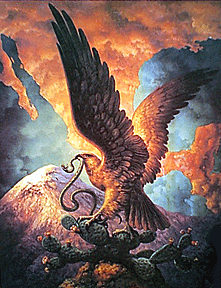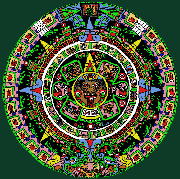HOW
DID MEXICO GET ITS NAME?
by Bob
Brooke
  While
the official name of Mexico is Estados Unidos Mexicanos or the
United Mexican States, most people know it as just plain Mexico or as
Mexicans say it Mejico (The j is pronounced like an h."). While
the official name of Mexico is Estados Unidos Mexicanos or the
United Mexican States, most people know it as just plain Mexico or as
Mexicans say it Mejico (The j is pronounced like an h.").
The original word for
Mexico was probably Meshtleeko. This word was a mine field of
pronunciation for the missionaries. Native Spanish speakers have a
difficult time pronouncing sh, whether in an English or a Mexican
word. As a result, they inserted an x in any word containing sh,
thus x came to be pronounced sh.
As the first missionaries
to come to the New World from Spain, the Franciscans used the x
to help commit indigenous Mesoamerican languages to script using Latin
characters. Whenever they couldn't translate the sounds of letters to
Latin, they used an x, much like an "unknown" in
mathematics. As linguists, these friars faced the problem that there
were sounds produced in the native languages that didn't exist in
Castillian Spanish. The guttural j is an example of this (similar
to ch in German, as in Heinrich), and another is the x
mentioned above, the case of the sh sound, as in
"shoe." The native people, on the other hand, had similar
problems with Spanish sounds that didn't exist in their own languages.
So the missionaries used an x to stand for many varying sounds--f,
guttural j, sh, s and ks. The uncertainty
regarding which of these sounds x was meant to symbolize in any
given word is what leads to present-day confusion.
So, the simplified Mexico
evolved from the fact that the original Meshtleeko was truly
difficult for native Spanish speakers to render. Within a few
generations after the conquest, people replaced the original sh
sound that the x symbolized by the more common interpretation of x,
the j. This occurred because native Mexica speakers nearly
disappeared from the central Valley of Mexico in the first few decades
after the conquest and those few remaining weren't influential at all.
Those Spaniards across the oceans who administered their new possessions
on the basis of written reports issuing from colonial governors didn't
have the guidance of native speakers of Mesoamerican languages to
properly interpret the "Latinized" versions of native words.
Because of this,
Spaniards soon began writing the name of the country as it was
pronounced--Méjico. Mexicans themselves have continued to use
the Mexico version. Even though both pronunciations are as far from the
original Mexica word, the usual reason advanced for this is that this
word and its present spelling connect Mexico with its historical past.
To read more articles by
Bob Brooke, please visit his Web
site. |

